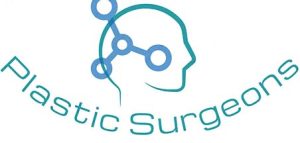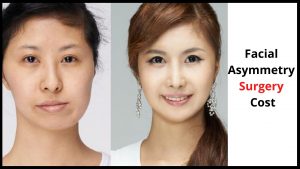
Courtesy: ID Hospital
The cost of facial asymmetries depends on how much work needs to be done to correct the issues.
And the more work there is, the more the surgery will cost.
Another factor that goes along with facial asymmetry correction is the complexity of the problems and the extent of facial asymmetries.
If the patient only needs to have their jaw region altered, the cost of this procedure will be lower than if they need to have all of their facial features affected.
Facial asymmetry, when paired with low bone density and limited facial expression, can be a very debilitating condition.
Facial Asymmetry Surgery Cost – Cost breakdown and Details!
The term “facial asymmetry” describes the fact that some people have naturally larger faces than others; in these individuals, the size of one or both sides of their face may vary by a wide margin.
Typically, facial asymmetry is not severe enough to require surgery, but it may be enough to cause depression and other emotional problems.
Although facial asymmetry surgery cost varies from case to case, it can be expensive.
These processes will have a direct impact on how much facial asymmetry surgery costs.
Before you choose how much facial asymmetry surgery costs, it’s a good idea to discuss your surgical options with a qualified plastic surgeon.
He or she will be able to evaluate how much facial surgery will cost based on the amount of muscle removed, the degree of facial scarring, and your overall health.
The cost of facial asymmetry surgery, therefore, largely depends on your overall health and age.
Your surgeon will also be able to provide you with realistic expectations about what the procedure might entail, both during the preoperative and postoperative stages.
Once you know how much facial asymmetry surgery will cost, you can determine how much that you can afford for the procedure.
Make sure that you keep your doctor informed about your current finances, such as any outstanding credit card or medical bills.
If your surgeon determines that facial asymmetry is required for you to maintain a symmetrical appearance, he or she may offer you financing options.
Many plastic surgeons offer a low-interest, deferred-payment plan that allows you to pay off your surgery over time.
Keep in mind, however, that these types of plans usually come with a significant price tag attached, so you should expect to pay quite a bit of money upfront.
Typically, a surgeon will perform the procedure on an outpatient basis, after making sure that the patient is healthy enough to undergo the procedure.
The procedure can take anywhere from one to three hours, and patients can usually return to work the next day.
This time away from work, however, can add up over time, and patients should budget accordingly.
There are many causes of facial asymmetries, ranging from genetic factors to hormonal fluctuations to the way a person breathes.
(Asymmetries are also sometimes caused by jaw disorders such as spaced teeth or a pronounced jaw angle.)
Cosmetic surgeons specialize in repairing aesthetic facial asymmetries, making them experts in the correction of drooping eyelids, crooked noses, overly large ears, undersized lips, and the excess fat tissue between the muscle and the bones of the face.
Other methods used to correct facial asymmetries include fat transfer or liposuction.
Liposuction, in which a patient’s fat is sucked out by surgery, can be very successful in removing facial asymmetries; however, it is not without risk.
There are a few ways cosmetic surgeons reduce facial asymmetry after a surgical procedure.
If there is not enough natural tissue to correct the problem, the surgeon may surgically remove more than just one part.
For instance, if left untreated, a patient with a widely spaced face could undergo a chin-tightening surgery to bring his chin closer to his forehead.
Many plastic surgeons then use skin grafts to cover areas of excess tissue that were removed during surgery.
Sometimes patients have difficulty meeting the desires of their facial features because they cannot perfectly match their upper and lower jaws.
In this case, a plastic surgeon can reshape the lower jaw to give the patient more room to widen his facial features.
Sometimes the jaw can move out of position in ways that make the upper and lower jaw look asymmetrical.
In cases like this, the plastic surgeon might use scalpels or dental implants to push the jaw back into place.
Another common problem caused by asymmetry in the face is jowl creases.
Many people have unevenly shaped jowls because they have gone through excessive smoking or drinking.
Jowl creases can be minimized by taking several small steps to eliminate the problem.
First, patients should lose weight and stop smoking, and then they should get in shape.
Plastic surgeons can perform surgical facelifts to improve the prominence of the jowls, as well as other ways to restore their original appearance.

Facial Asymmetry Surgery – What you need to KNOW!
Facial asymmetries are present at birth and many people have them.
In most cases, they occur very subtle and are unnoticeable.
For some people with facial asymmetry, surgery may be an option.
If your facial asymmetry is causing you to look less than attractive then facial asymmetry surgery may help.
It is important to understand that facial asymmetry surgery is only one option and you have other options as well.
Facial asymmetries usually occur because of aging.
As people get older, their facial bones grow thinner and their nasal bones grow longer.
Facial asymmetries also tend to show up more as men age since facial asymmetry surgery will affect bone growth.
The reason behind this is that because facial bones are affected by facial bone placement and projection, which affect the location of the facial nerves.
With facial asymmetry surgery, you have the option of having it done to address both of these issues.
Another important thing to know is that with any surgical treatment, it is important to follow the instructions of your doctor to get good results.
The improper surgical procedures or lack of follow-up care can both cause you to not get good results.
Be sure to do your research and talk to your doctor before deciding if facial asymmetry surgery is the right choice for you.
Now we turn to what the plastic surgeon will do after the surgery has been performed.
The surgeon will take images of your face at different angles and will work with skin grafts from one side to cover the areas that were done with facial asymmetry.
Now, this is where complication sets in.
If you’re patient enough and educated enough, you’ll realize that it’s not as easy as cutting a pocket on one side of your face to cover the other.
Your surgeon has to make several assumptions in order to get the right grafts.
After facial asymmetry correction surgery, your face will need time to heal in order to minimize the look of imperfections.
It’s not uncommon for patients to experience some swelling or pain in the immediate aftermath of the operation.
This will only be temporary and should subside within a few weeks.
After this, you should be able to see an improvement in the appearance of your face, though it’s still important to be vigilant about keeping your face moisturized and to pay attention to the way you shave.
If you find that you still have some asymmetry after facial asymmetry surgery, then you may be a good candidate for another procedure.
In this procedure, the surgeon gently heats the wrinkles on your face using high-energy lasers in order to smooth out your skin.
This procedure can reduce your appearance even more since it can reshape the bone structure under your skin.
When this process is combined with filler, you can get the result of a perfectly symmetrical and crooked face.

Types of Facial Asymmetry
Understanding the various types of facial asymmetry can be important for several reasons.
It is not unusual to see several different facial aging signs such as drooping eyelids, frown lines, folds in the forehead, heavy-lidded eyes, and other wrinkles that are typically associated with facial aging.
Understanding what these differences are and how they are related, can allow a person to take appropriate steps to counteract or slow down the signs of facial aging.
Another reason why understanding facial asymmetries are important is because of their potential impact on how a person feels and looks.
Many people are not aware of facial asymmetries, so they do not know how to handle or cope with them.
Here, we’ll go over some of the different types of facial asymmetry and look at how they may affect you.
Types of Facial Asymmetry:
1. Complete facial asymmetry
2. Incomplete facial symmetry
3. Asymmetrical Facial Aging Signs
4. Structural asymmetry
1. Complete facial asymmetry:
Complete facial asymmetries refer to when both sides of your face look drastically different from each other.
This can happen because of a significant amount of muscle tone variation between the left and right sides of your face.
On the other hand, complete facial asymmetries can also be caused by significant changes in bone density or muscle laxity.
Complete facial asymmetries are the least of your problems with facial asymmetries.
2. Incomplete facial symmetry:
The second type of asymmetry that you need to be concerned about is incomplete facial symmetry.
When your face is asymmetrical, it means that one or more areas of your face are looking significantly different from the other side of your face.
This can happen for many reasons, such as a loss of muscle tone due to age, disease, or even weight gain.
In some cases, this form of asymmetry may actually be genetic.
If you have a close family member who is suffering from facial asymmetry, you should definitely consider getting surgery designed to correct the situation.
3. Asymmetrical Facial Aging Signs:
The Asymmetrical Facial Aging Signs of this type can usually be detected during a recent exam by a qualified doctor.
If the doctor finds that one side of your face is noticeably different than the other side, then he or she may order a complete or partial facial analysis.
From this analysis, doctors can determine if the asymmetry may be caused by something like an accident, certain medications, or even your natural facial features.
Once the doctor has determined the possible causes of the asymmetrical face, he or she will be able to design an effective treatment plan for that specific condition.
For many, there are effective treatments for asymmetrical facial aging that involve taking care of your overall health, as well as addressing the asymmetry in a subtle and well-defined way.
4. Structural asymmetry:
Structural asymmetry or structural alignment is one of the most common causes of asymmetry.
Well, structural asymmetry can easily be corrected through any procedure of this type.
Any facial structure that is not congruent with the anatomical structure is known to be affected.
For example, Any facial growth that is not symmetrical with respect to the other side of the face can be corrected through surgical methods.
Of course, you don’t have to go through drastic means to get rid of your facial asymmetries.
If you want a less extreme option, you should look into using non-surgical skin tightening procedures.
Skin tightening is an old-fashioned idea that continues to be popular, but its main drawback is that it doesn’t always work.
For example, most people who undergo collagen injections or who have Botox sessions usually end up looking even older in ten years’ time.
Fortunately, there are a number of nonsurgical options available to you if you are interested in addressing your facial asymmetries.
One of them is to use anti-aging eye creams.
These eye gels are specially formulated to combat signs of aging around your eyes.
They can either be applied to the area itself or to the wrinkles that appear on your eyes.
Another form of nonsurgical treatment for aging hands and aging faces is called photodynamic therapy.
This kind of treatment works by improving the skin’s moisture content, thereby making wrinkles less visible.
Even though this may sound like a cure-all, it is important to note that you shouldn’t expect this technique to work for every case of facial asymmetry.
It has been shown that many gels and lotions are only effective on people suffering from a specific underlying medical condition.
In other words, you won’t be able to use just any gel or lotion and get perfectly smooth and wrinkle-free skin.
Before spending money on these treatments, you should be sure that you are not allergic to the ingredients in the products.
If you are, then you might not see results as you would if you were allergic to the underlying medical condition.
Finally, there are some surgical procedures that can address the cause of facial asymmetry.
For example, eyelid surgery can correct folds and creases around the eyes, as well as soften lines around the mouth and nose.
Soft tissue asymmetries such as cheek and neck lifts can also be corrected through liposuction.
A facelift is another surgical option.
However, if your goal is to get rid of unsightly scars and restore facial asymmetry, you should look into laser surgery or fractional laser resurfacing.
Eyebrow surgery, frown lines, smile lines, forehead creases, temples, eyebrows, and upper lip creases are all conditions that may affect one side of your face more than the other.
In these cases, one type of treatment may address the issue better than another.
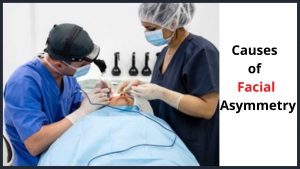
Causes of Facial Asymmetry
There are many possible causes for facial asymmetry:
1. Trauma that impacts the nose
2. Crooked nose surgery
3. Altered nose surgery
4. Other facial cosmetic surgery
5. Rhinoplasty
6. Stroke
7. Torticollis
8. Bell’s palsy
9. Lifestyle habits
10. Injury
11. Aging
12. Dental work
13. Sun damage
14. Smoking
15. Genetics
So does it really make any difference if your face is already asymmetrical?
Face asymmetry actually is considered by many to be a defining part of physical beauty, but only perfectly symmetrical faces aren’t always the best.
Here is what I found.
The fact of the matter is, not all people born with facial asymmetry have it caused by one single cause.
In fact, sometimes people born with facial asymmetry actually have a combination of more than one cause.
For example, one of the most common causes of asymmetry is congenital abnormalities.
There are also other causes of asymmetry like severe burns or surgeries that completely change the shape of a person’s nose.
In the case of congenital abnormalities, if the abnormality is detected at birth and medical intervention can be prevented, then the risk of the person developing asymmetry will be substantially reduced.
Another possible cause of facial asymmetry is jaw surgery.
If one or both of the upper or lower jaws become misaligned, this can also lead to facial asymmetry.
In some cases, jaw surgery will lead to a change in the length of the person’s chin, which can also affect facial asymmetry.
However, jaw surgery isn’t considered to be one of the main causes of facial asymmetry.
If one or both of your jaws are seriously affected by jaw surgery, you may want to consider getting a second opinion on your surgery.
For this, you should contact your general dentist, as many dentists these days are skilled enough to perform non-invasive cosmetic dental procedures.
In many cases, the causes of facial asymmetry are linked to genes, though you can do certain things to help prevent this from happening to you.
One thing you can do to help prevent it is to get regular checkups.
Many times, problems with facial symmetry can be genetic.
To determine if this is the case for you, talk to your doctor about possible gene treatments.
Another thing that causes asymmetry is birth weights and the position of the eyes.
In many congenital sop patients, doctors notice that the eyes are noticeably different from one another, but they are still within normal limits.
Because this occurs so frequently, doctors started keeping records of newborn photographs when they were taken.
Over time, these records started to become extremely valuable.
Today, you can look back on them and see how these infants looked like at different ages and that of their eyes was most significantly different.
Even though you cannot pinpoint exactly what causes facial asymmetry, you can always take steps to minimize its appearance.
Since the face is often the first noticeable part of the body, you should always ensure that you keep your face clean and tidy at all times.
It is best to go to bed at the same time each day and to try to sleep with your head in the same position.
When your skin’s elasticity is negatively affected by excess weight or physical activity, you can use a neck pillow to keep your neck aligned properly.
These are some of the most common causes of facial asymmetry, and there are plenty of ways to fix them if you do not want to let the problem get out of hand.
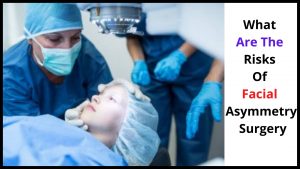
What Are The Risks Of Facial Asymmetry Surgery?
In general, some of the greatest risks of facial cosmetic surgery stem from the surgeon performing the procedure.
When I say surgeon, I mean the person who performs the procedure.
There are many surgeons out there who have a range of philosophies and beliefs.
While they all may be good at what they do, there is always the chance that their personal beliefs will come into play while performing the procedure.
The most common risk of facial cosmetic surgery is that there is an adverse reaction to the anesthesia used during the procedure.
This can range from feeling like you’re in a coma or feeling like your face is on fire.
It is important for the patient to realize that these feelings are entirely normal after the operation.
If you’ve had facial plastic surgery before and it went well, then you should have no concerns about this.
However, if you had a bad experience or the results were less than you want or hoped they would be, you should make sure to discuss what the risks of facial asymmetry surgery are with your doctor.
Another big risk of facial cosmetic surgery is the possibility of permanent scars.
Scarring is one of the most common and most serious side effects of facial plastic surgery.
While scarring is inevitable after any type of surgical procedure.
The good news is that the scarring that can result from facial cosmetic surgery is usually not very visible and often blends in with the surrounding skin.
Scarring is one of the most common reasons why patients request the removal of fat from one side of the face to make the face appear more slender or vice versa.
Scarring is also one of the most serious risks of facial asymmetry surgery.
What are the risks of facial asymmetry?
Any type of facial cosmetic surgery carries risks, but asymmetry is especially common.
While there are ways to minimize the chances of developing facial asymmetry, some patients still end up with asymmetry.
This occurs when one side of the face develops thicker hair or fat that covers the eyes or cheeks while the other side has more hair or less fat.
The good news is that there are ways to correct facial asymmetry.
One of the most common ways to correct facial asymmetry is through liposuction.
This procedure is done by removing excess fat or tissue from areas on one side of the body where it causes a discrepancy in the shape or size.
Another option is a facelift, which corrects the lines and folds on the face.
Both procedures are relatively safe, although patients should always check with their doctors for possible risks and complications.
Some of the most serious risks of facial cosmetic surgeries can include nerve damage and permanent vision problems.
Nerve damage is a risk of any plastic surgery, and liposuction is no different.
Liposuction is a delicate procedure that requires incisions, and the nerves can be damaged if the patient is not prepared for the procedure.
For instance, patients who have undergone a facelift may find that they suddenly have a pinched nerve in the area of their cheeks.
This condition is referred to as a “double chin.”
Because the surgeon must cut through the skin in this area and insert the instrument through the skin, this can lead to a long recovery time and great discomfort.
One of the most common areas of facial asymmetry is the nose.
Women with a deviated septum may want to consider rhinoplasty as an option for correcting the problem.
The septum is the cartilage that separates the two halves of the nose.
The cartilage will eventually wear down on both sides and this is where the ‘deviated septum’ comes into play.
Rhinoplasty is a plastic surgery procedure, which can be very successful for those patients who have nose asymmetry.
However, if you suffer from chronic nosebleeds, then the procedure may not be successful and may even cause more problems.
Some other risks include complications such as bleeding and infection.
This usually occurs if the incision was not properly done or if too much scarring has occurred.
Infection can occur if the implant has been inserted too deep or if it is near the bone.
Bleeding can be very serious if it happens during the first week after the operation because the tissue around the incision could be very sensitive and bleed easily.
Some of the most common areas where infections have occurred include the nose, the ears.
If this happens you will have to visit the hospital as soon as possible for treatment.
As with any surgical procedure, there are certain risks that are associated with facial asymmetry.
One of these is facial swelling, which can be quite severe during the recovery period.
Make sure that you have someone with you at all times that can help support you as you heal.
You may need some physical therapy and you should inform your surgeon if you have any existing back neck or hip issues.
While facial asymmetry is not the only procedure that can lead to these kinds of complications, it is the most common.
In addition to the risks of facial asymmetry surgery, patients should also be aware of the risks of general surgery, including facial implants, tummy tucks, and rhinoplasty.
Any time an incision is made in a sensitive area, there is a chance of infection.
These risks are rare but it is always better to be safe than sorry when it comes to cosmetic procedures.
The good news is that if the risks are rare then the chance of having a successful result is even rarer.
If you feel that you have been pre-disposed to facial asymmetry then it is always a good idea to talk to a cosmetic surgeon about the risks of facial asymmetry surgery.
They will be able to evaluate the situation and help you determine if you are at risk.

Is Facial Asymmetry Surgery Covered By Insurance?
Depending on the health plan you have, this can be a question that you may not be able to answer.
The fact is that there are many cases where facial asymmetry and other aesthetic issues are considered a pre-existing condition and therefore, it is not covered.
However, it is important to note that if you are suffering from a medical condition that impairs your ability to achieve an attractive smile, you may be able to obtain coverage for the procedure.
In such a case, cosmetic surgery may be necessary to address the issue.
One of the most common deformities of both males and females is facial asymmetry.
The asymmetry occurs when one side of your face develops characteristics that aren’t present on the other side.
This can include a nose that doesn’t form or a lip that’s either too small or big for your body.
Insurance typically doesn’t cover facial asymmetry, but you may want to explore your options if it is medically necessary for you to address the problem.
There are two primary reasons why facial asymmetry can occur.
The first is because of congenital factors, which include birth defects that are present at birth.
These can include things like microtia, which are small bumps on the surface of the skin that can be caused by malformations during the development of the baby.
Other congenital facial asymmetries can include conditions like cleft lip and palate, double chin, and some facial disfigurements that affect the width of the nose, chin, or cheeks.
If the birth of a child creates facial asymmetry, other factors can cause it.
They could include heredity, illness, injury, or a medical condition.
Some birth control pills have been known to cause facial asymmetry.
So you may want to speak with your doctor if you’re taking any medications that could affect the appearance of your face.
Illness can also contribute to this problem.
For example, a common illness among women over the age of fifty is osteoporosis, which can weaken the bones in the face.
The good news is that if facial asymmetry surgery is medically necessary, it most often is covered by insurance.
In fact, many cosmetic surgeries, including those for the nose, chin, and cheekbones, are classified as recoverable.
Even surgeries involving the cleft lip and palate and double chin are typically covered by insurance, so long as certain requirements are met.
Speak with your cosmetic surgeon if you have any concerns about whether a certain procedure will be covered.
What is more, if you have qualified for disability insurance and the cost of your dental treatment is more than the amount of your monthly disability check, cosmetic procedures which may affect the appearance of your mouth and teeth may be covered by your insurance carrier.
To find out if your insurer covers such treatments, you will need to contact them.
This is because some plans only cover elective cosmetic surgeries like implants.
If you qualify for a standard health plan, your insurance company should be able to provide you with a list of providers who do offer coverage.
In some cases, your provider will only cover the cost of facial asymmetry if you are also receiving oral surgery.
In such a case, they would only pay for the portion of the procedure that addresses the facial asymmetry.
Therefore, if you are undergoing oral surgery, it is a good idea to also get your surgical procedure done to address the facial asymmetry.
In this way, both procedures would be covered by your insurance provider.
If not, you would need to pay for the entire amount upfront.
Many people wonder if they would be able to afford to have such an operation if they are not in excellent physical condition.
This is especially true if you don’t have a lot of extra income to spare.
If you are not married and have no children yet, then the best way to answer that is to consider the total cost of facial asymmetry for a lifetime.
Yes, it would cost you a lot of money – but if you are concerned about how your face may look in a decade or two, then the costs are definitely worth it.
The other common question is about the possibility of having a procedure done if the underlying cause of your facial asymmetry is not something that can be treated through plastic surgery.
For example, if you are born with congenital symmetry in your face, then most insurance companies won’t cover the cost of the facial operation.
However, there are many other reasons why facial asymmetry may occur, including poor posture and poor diet.
These kinds of procedures are considered to be reconstructive and thus are covered by most insurance policies.
To find out more about what insurance plans offer regarding facial asymmetry coverage, check with your policy or talk to a representative from your insurance company.
They’ll be able to tell you more about the types of procedures you’ll be able to get covered, the amount of coverage, and the details of what’s considered to be an emergency.
Remember, however, that even if a certain procedure is covered by your plan, there are always exceptions.
Before you spend money on treatments you might not be able to use, make sure your insurance provider knows what you’re planning on using them for.
When it comes to facelifts and other similar procedures, many insurance policies won’t cover the entire cost.
If you have facial asymmetry, you may need to pay out-of-pocket.
This can take a lot of time and money, though, and if you’re in a financial bind, you may not have the extra funds available.
For this reason, it’s important to ask your cosmetic surgeon about what’s covered in your insurance policy.
It’s also a good idea to do research online, read reviews from other patients.
And talk to insurance representatives to see what they can tell you about which procedures are currently available.
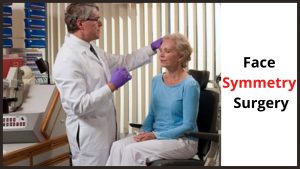
Face Symmetry Surgery – Is There a Face Symmetry Surgery?
There are many reasons why you might consider facial symmetry surgery, the most common of which is a facelift.
The facelift is considered a face symmetry surgery and it can make a big difference in your appearance, especially if you have excess skin hanging from your chin or cheeks.
The more excess skin you have, the more prominent your wrinkles and the more noticeable your double chin will be.
This is where an Invisalign procedure can help to correct this issue.
It can also help to remove excess fat that you have on your face, which is another reason that people consider this operation.
Many women consider a face-symmetry procedure if they have spent years trying to smooth their faces and eliminate signs of aging.
A facelift will tighten the skin on your face, which will take away your double chin.
It can also help to eliminate any sagging skin on your face and neck.
If you suffer from chronic back pain, a facelift can relieve this problem, as well as other problems that you might be experiencing.
If you are thinking about getting a facelift, then the first step is to find a plastic surgeon who performs face symmetry surgery regularly.
During this consultation, the surgeon will talk to you about all of your options, so that you will know exactly what you are getting involved with.
You will likely be advised to go to multiple appointments in order to get your desired results.
It is best to do some research on the internet to find a surgeon who is experienced with doing these procedures.
You should also look for reviews of plastic surgeons online to see how others feel about their skills.
If you are interested in getting face symmetry surgery, you will have to first understand just how it works.
You can expect to get a procedure that is known as a rhytidectomy.
This surgery will reduce the size of your nose, as well as reshape your cheeks, chin, and jawline.
Your surgeon will use the patient’s own skin to create your new nose, taking precise measurements before the surgery to make sure that he makes the incision in just the right spot.
After the surgery, you will have scars that are normally invisible and will need to cover them up for about a year.
If you are interested in getting a facelift, you will have to start by going to a consultation with your surgeon.
During this time, he or she will examine your face and talk to you about your goals.
You will then get specifics on exactly what the procedure will entail, and what your recovery and downtime will look like.
After you have made the decision to get the facelift done, then you will be ready to arrange to finance.
Many insurance companies do not cover the cost of facelifts because they are known to be medically unnecessary.
It is important that you take your time when deciding which surgeon to go with.
Make sure that you do your research and find out as much as you can about the procedures that they are offering before you make any decisions.
Also, it is important that you work closely with the surgeon during the process, so that you know exactly what is happening to your face.
Overall, facelift surgery will not only change your appearance but could also improve your confidence.

Who Is A Good Candidate For Facial Symmetry Surgery?
Many patients also wonder if they are suitable candidates for Facial Symmetry Surgery.
A qualified plastic surgeon will be able to answer these questions and provide a comprehensive analysis of your overall health.
If you do not meet the surgeon’s minimum recommended criteria for facial symmetry, then there could be other options that are more appropriate.
In many cases, it is possible to reduce facial lines and wrinkles through surgical procedures.
Surgical procedures are typically only performed on patients who have an adequate degree of healthy flexibility and are in excellent health.
Prior to the surgery, the surgeon will perform a thorough physical exam and evaluate your skin quality and symmetry.
The purpose of this assessment is to determine whether you are a suitable candidate for Cruciform (CUV) Part II or III facial fillers.
If you are not a good candidate for these procedures, then you may wish to explore your options with less invasive alternatives.
If you are considering undergoing facial asymmetries or other facial cosmetic surgery, you will first need to make an assessment of yourself.
There are many factors that can determine whether you are a suitable candidate for this procedure or not.
For example, are you a good candidate if you have large facial wrinkles or sagging skin around your eyes?
Or, are you a suitable candidate if you have drooping eyelids or double chins?
Or, are you a suitable candidate if you have lost most of your facial skin since you were a child?
These are just a few examples of things that can determine whether or not you can achieve facial symmetry.
If you think that these are the only factors that determine whether or not you are a good candidate for facial asymmetry, then you are wrong.
It has been found that one’s height, weight, skin/facial tone, and even DNA can affect the appearance of facial asymmetries.
So, if you want to look your best, regardless of what caused your facial asymmetries, you will want to invest in a consultation from a board-certified plastic surgeon.
Fascial asymmetries can also be caused by medical conditions.
One of these conditions is a hyaluronic acid deficiency.
This condition is more common with people who are Asian Americans because of the specific facial asymmetry surgery procedures that are used to treat the condition.
If you are a suitable candidate for Facial Symmetry Surgery, then you should begin to research the procedure in depth.
There are many different options available for those who wish to undergo the procedure.
Some clinics and offices offer it as an outpatient procedure that does not require an overnight stay.
Others require that you remain in the hospital for the procedure and some may even require that you be in the hospital for a couple of days prior to the actual procedure.
You should consider your level of flexibility when choosing which procedure is most suitable for you.
In general, those who have an overall symmetrical face are the most suitable candidates for facial symmetry surgery.
However, those with minor to moderate asymmetries may also be a good candidates.
Additionally, women who are within a couple of years of menopause are also considered to be suitable candidates for the procedure.
Typically, the procedure is performed on an outpatient basis.
During the procedure, the areas affected by facial asymmetries will be injected with fillers such as botulinum toxin.
Although facial symmetry and dermal fillers can provide noticeable results, they are not permanent.
You can always undergo another procedure to correct your problems, but this will cost a lot of money.
Before deciding on whether you are a good candidate for facial symmetry surgery, you should discuss your options with your doctor.
This will help ensure that you make a well-informed decision regarding the surgical procedures that are best suited for your unique situation.
Even after you have determined if you are a good candidate for facial symmetry surgery, the actual procedure can vary from person to person.
There are two surgical procedures that are commonly used to correct facial asymmetries.
The first type of procedure is known as a mini-rhytidectomy.
With this procedure, the surgeon will eliminate certain portions of your nose.
The other type of procedure is known as chin reduction.
This procedure will reduce the size of your chin so that the person will have a better balance.
If you think that you are a good candidate for this surgery, you should contact your physician to discuss the details of the procedure.
They will give you all of the information that you need to know about the procedure so that you can decide if you want to go forward with it.
Once you have completed your evaluation and have decided if you want to go ahead with facial fillers to fix your asymmetries, your doctor will give you an estimate on how much the surgery will cost you.

Where Are The Focus Areas In Facial Symmetry Surgery?
In a nutshell, facial symmetry is an aesthetic benefit that can be derived from surgery.
It can be acquired through surgical procedures and non-surgical procedures that are performed in the office under the care of a licensed plastic or reconstructive surgeon.
Facial asymmetry occurs when one facial feature is significantly different from another feature.
This could be caused by albinism, congenital defects, facial trauma, burns, facial surgery, or other factors.
Facial symmetry occurs in pairs so that if one is significantly different than the other, the asymmetry will be apparent.
Although there are no cures for facial asymmetries, certain treatment options are available to improve the appearance of your face.
What are the typical focus areas in Facial Symmetry Surgery?
Here are some of them:
1. Fused scars and substandard scars.
2. Substandard scars and facial asymmetries.
3. Recurring facial asymmetries.
4. Lowlights and fillers.
5. Surgery procedures that alter the position of bones or long bones.
1. Fused scars and substandard scars.
Both of these can be corrected through surgical procedures.
The surgical procedures used for this purpose include dermal fillers, collagen, and injectable gels.
These filters will make the scars less visible and will improve their appearance.
2. Substandard scars and facial asymmetries.
Both of these can also be corrected through surgical procedures.
The surgical methods used for this purpose include dermal fillers, collagen, and injectable gels.
These filters will not only improve the appearance of the scars but will also make the skin on the face look firmer.
They will also enhance facial symmetry.
3. Recurring facial asymmetries.
One of the common reasons why facial asymmetry occurs is due to the fact that there are a lot of bones in the face.
Therefore, if there are a lot of bones in one area, the face will be deformed because there will be an uneven amount of space between the bones.
This can also cause facial asymmetries.
For this reason, it is necessary to correct these irregularities using surgical procedures that will help in restructuring the facial bones and taking away all the bone spurs that cause facial asymmetry.
4. Lowlights and fillers.
Lowlights are used for improving the look of the eyes and for making them appear wider.
These are also used in facial symmetry surgery to make the eyes look more proportional and to improve their size.
Similarly, fillers are used in surgical procedures to enhance facial symmetry.
For instance, if one eye has a greater width than the other, then the fillers will be used to enhance the overall appearance of the eyes so that they will look proportionate.
5. Surgery procedures that alter the position of bones or long bones.
Most people have strong bones that remain unaltered from their birth.
However, due to aging or because of other factors, their bones grow out of place.
This causes facial asymmetries and other problems like creases in the forehead, drooping eyelids, and neck pain.
When these problems are fixed through surgical procedures, the face will no longer look deformed or unnaturally large.
All in all, you should be very happy with the results of your facial symmetry surgery.
If you notice asymmetry even after your surgery, then you should see a board-certified plastic surgeon right away.
Before your procedure, your surgeon will examine your face and discuss the possible causes of the problems.
It is important that these issues are addressed right away to prevent them from coming back later on in your life.
In addition, by fixing the issue in the early stages, you can avoid any long-term effects from these issues.
The most common causes of facial asymmetry are severe accidents and injuries.
People who abuse alcohol or do not exercise properly are also at risk of developing facial asymmetry.
These are just a few of the reasons why facial asymmetry occurs.
Aside from physical factors, emotional stress, and trauma are also considered as causes of facial asymmetries.
You may have an asymmetrical face because of your past.
If this is the case, the best thing that you can do for your now is to face the problem as soon as possible so it won’t affect your future.
Another advantage of undergoing facial symmetry surgery is that it can help improve your confidence.
If you are constantly stressed about the size of your nose or the shape of your eyes, you may feel unattractive and awkward.
In addition, a lot of cosmetic and plastic surgeries today can improve your appearance and make you more beautiful.
However, the good news here is that there are lots of available surgical procedures that can help enhance facial symmetry.
In order to determine if you need facial fillers or dermal fillers, you have to know more about your facial asymmetries.
For example, if you have deep wrinkles around your eyes, then it is likely that you need to undergo a surgical procedure to enhance facial symmetry.
It is best to consult your surgeon so you would be guided accordingly.
If everything goes well, you would be pleasantly surprised by the outcome of the facial fillers or dermal fillers.

Does Sleeping On Your Side Cause Facial Asymmetry?
If you are looking for a common cause of facial asymmetry, then the answer is, unfortunately, yes.
Sleeping on your side often causes facial asymmetry because your nose is pushed to the back of the throat while your mouth is closed.
This position makes it difficult for air to flow through the mouth and nose to the lungs, causing a feeling of sleepiness and decreased oxygen levels.
While not as common as other causes of facial asymmetry, sleep on your side can cause more significant changes in a person’s facial appearance.
The best way to determine whether or not sleeping on your side will cause a difference in your appearance is to ask yourself what might be happening if you did sleep on your side.
For example, did you wake up one morning with a nose that was much bigger than the one you had when you went to bed?
Or did you wake up one morning with cheeks that were wider than normal?
Narrowing the nasal width, or pushing the tip of the nose forward, could cause an asymmetrical appearance to the rest of your face.
While sleep on your back is most likely to cause a difference in facial asymmetry, there are other things that can cause it.
If you are overweight, or if your head is unusually small when you are asleep, then sleeping on your side may not be the best option for you.
In these cases, a pillow may be an appropriate solution.
However, if you are sleeping in an upright position, then you have the choice of trying different methods.
As for other reasons why you might be seeing an asymmetrical appearance on one side of your face, then the culprit could be the position in which you sleep.
If you are a back sleeper, but you always sleep on your side, then the side you sleep on will most likely be more affected.
Also, if this is the case, then there are several things that you can do to change your sleeping habits.
You can choose to either avoid sleeping on your back altogether or modify your sleeping habits so that you are sleeping on your sides more.
Either way, however, you should watch for the facial asymmetry as you progress through your life.
As for whether or not sleeping on your side will cause you to see an image of a person whose eyes are wider than their face.
To answer this question, it would be important to look at some examples.
For instance, imagine that you are looking in a mirror and someone else is looking right at you.
If you view the other person’s eyes as wider than yours, then it may cause you to see an image of a person who has wide eyes.
It is possible, of course, that if you are seeing a picture that someone else drew with wide eyes, then you may simply see an exaggerated version of what you actually see.
But even if the image causes you to view the other person’s eyes as wider than they really are, this will not necessarily be a bad thing.
So, does sleeping on your side cause facial asymmetry?
At this point, the answer is Yes, and it is something that you will have to keep in mind.
Because as you get older, your face will begin to naturally droop over time, and this can be very disconcerting to many people.
If you do experience this problem, try to take steps to make sure that you don’t fall asleep on your side.
Since this can lead to an apnea episode where you wake up with your mouth open and your nose and cheeks stuffed full.

Conclusion:
Facial asymmetry can be caused by various factors such as genetics, injury, or trauma, facial expressions or posture, facial expressions, muscles tone, diet, or even medicinal medication.
It can be caused by a tumor of the lymphatic system or nerve.
Facial asymmetry can also be caused by the skin folds on the face that are present.
If the skin is overgrown or folds present, it can cause asymmetry in the appearance of your face.
Even if facial asymmetry is only a minor cause of asymmetry, there are still ways to correct the problem.
There are a number of methods for correcting facial asymmetry, but one of the best ways of all is through surgery.
